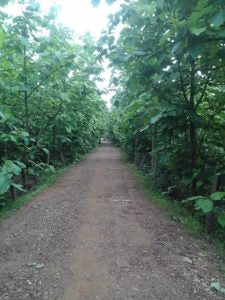We have multiple food forests across India associated with us, each having a different nature of its own. The above map shows our current work footprint.
It takes us more than 7 years to create a natural farm ecosystem. Many of our Food Forests have around 175 types of big and small flora. Trees, flower plants, legumes, and vetiver- all come together to provide a good and abundant food place for honey bees, birds, hens and cows. Thus form our regenerative, self sustainable and closed loop food forests.
The typical layers in Central India are as follows:
- First (topmost) Layer: Large Trees like Neem, Morninga, Subabul, Gooler, Teak, Mango, Mahua, Indian Gooseberry, Chakrota (pomelo), Kadamba, Mulberry, Giloy, etc
- Second Layer: Papaya, Lemon, Sweet Lime, Custard Apple, Cheeku/Sapota, Guavas, and many such trees
- Third Layer: Toor (arhar dal), Urad, Mustard, Suran, Millets like Kodu/kutku/sama
- Fourth Layer: Ginger, Turmeric and similar structure plants, medicinal herbs, and other vegetables like Cherry tomatoes, Okra, Brinjals etc.
- Fifth Layer: Vetiver, Alfaalfa, Lemongrass, Aloe vera, Safed Musli
- Sixth Layer: Free roaming Poultry
- Seventh Layer: Cows
- Eight Layer: Honey bees: Pristine Mono floral Honeys available: Mango honey, Moringa Honey, Neem Honey, and many other varieties
- Isolated Ninth Layer: Silkworms and similar insects
- Isolated Tenth Layer: Water based Kamal Kadki, Fishes
A view of our food forests is below:
Central India:
In MP: 40 different villages in 5 districts. Each project differently and more beautiful than the other.
We have classified them into 4 types based on the feeling one gets in these forests:
Aranyaa (अरण्या)
Called Aranyaa due to its dense teak and forest like terrain, it is our main forest farm spread over 150 acres, and located in Sohagpur, Hoshangabad district. It has a guest house for our visitors, and a tiger reserve next to it.







Our many food forests farms are spread over 400 acres, located on the foothills of Amarkantak and around Narmada river.



Sheetal Van (शीतल वन)



 Srinagar (Uttarakhand), Vilĺage Thapla:
Srinagar (Uttarakhand), Vilĺage Thapla: Kinnaur and Solan :
Kinnaur and Solan :
 Ganges belt. Multiple small.guava orchards are the starting point. We are working with the farmers and UBA-IITK to change the orchards' economy and ecology.
Ganges belt. Multiple small.guava orchards are the starting point. We are working with the farmers and UBA-IITK to change the orchards' economy and ecology.


